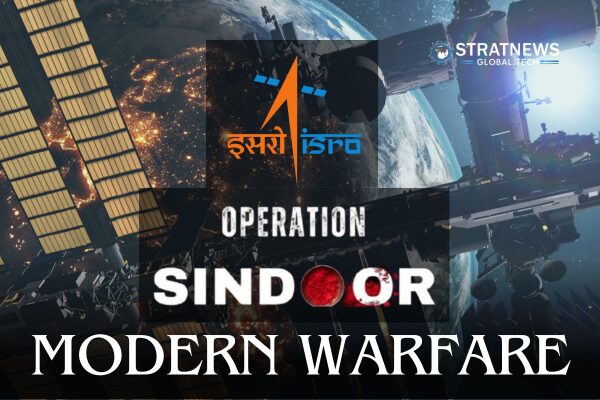Operation Sindoor: 10 Satellites, One Mission
As Indian Air Force fighters struck deep into hostile territory during Operation Sindoor, a quieter but equally crucial battle was being fought thousands of kilometersabove the Earth. Ten satellites operated by the Indian Space Research Organisation (ISRO) worked round the clock to provide the Indian armed forces with real-time intelligence, secure communications, and precision navigation. These silent sentinels of space transformed the battlefield, enabling India’s military to deliver a surgical and devastating response to the April 22 terror attack in Pahalgam—without crossing international borders.
Eyes in the Sky: A Strategic Force Multiplier
Speaking on May 11, ISRO Chairman Dr. V. Narayanan revealed the scale of this silent contribution:
“At least ten satellites are continuously working round the clock for strategic purposes—to ensure the safety and security of the citizens of the country.”
This revelation came just days after Operation Sindoor commenced on May 7, targeting nine terror infrastructure sites and eleven Pakistani air bases in Pakistan and PoK. These missions were made possible by ISRO’s seamless integration with the Indian military’s operational plans, providing everything from target intelligence to navigation support and communication security.
How Satellites Enabled Precision Warfare
ISRO’s constellation of satellites offered unmatched battlefield awareness. High-resolution Earth observation systems like the Cartosat and RISAT series delivered continuous surveillance across terrain, borders, and hostile airspace—regardless of weather or time of day. RISAT’s all-weather synthetic aperture radar (SAR) capabilities were particularly crucial in cloud-covered regions and mountainous terrain.
- Cartosat Series: Supplied optical imagery with sub-meter resolution for target identification and post-strike damage assessment.
- RISAT Series: Provided day-and-night radar imagery, which is ideal for detecting enemy movement and infrastructure.
- GSAT-7 and GSAT-7A: Enabled secure, real-time communication for the Navy and Air Force across long distances.
- NavIC (Navigation with Indian Constellation): Delivered high-precision geolocation data to guide missiles, aircraft, and drones with pinpoint accuracy.
These satellites allowed commanders to track enemy mobilization, confirm strike impact, and maintain real-time situational awareness, helping ensure the mission’s success with minimal collateral damage.
From Space to Strategy: Data-Driven Warfare
Satellite imagery and telemetry fed into a common operating picture used by the armed forces to select, verify, and prioritize targets. The use of both domestic and commercial data—such as from operators like Maxar—allowed for repeatable, layered imaging, which proved critical in high-value target validation. Officials confirmed that ISRO’s assets were essential in identifying hardened shelters, underground bunkers, and high-value air assets.
Moreover, ISRO’s experimental SPADEX mission—which demonstrated satellite-to-satellite rendezvous and docking—showcased a future where autonomous space manoeuvres could potentially support wartime logistics, surveillance, or asset repair in orbit. This capability, akin to a “satellite dogfight” at 29,000 km/h, reflects ISRO’s growing sophistication in space-based strategic operations.
The Expanding Military Satellite Architecture
India’s current military space fleet comprises an estimated 9–11 dedicated satellites, spanning imaging, radar, communication, and navigation roles. However, this is only the beginning. According to official plans:
The upcoming RISAT-1B (EOS-09) launch aboard PSLV-C61 on May 18, 2025, will add a next-generation radar imaging capability crucial for all-weather, day-night surveillance.
A Rapidly Mobilizing Space Doctrine
Following Operation Sindoor, the Government of India accelerated the timeline for India’s space-based surveillance network, condensing a four-year plan into a 12–18-month emergency deployment cycle. This strategic urgency has led to the following:
Dual-Use Excellence: Strategic and Civilian Integration
While Operation Sindoor highlighted ISRO’s military utility, its satellites remain vital across India’s civilian landscape—supporting agriculture, telemedicine, weather forecasting, and disaster response. The development of a climate-monitoring satellite for G20 nations demonstrates India’s intent to be a responsible space power, balancing hard power with global collaboration.
A Message Sent from the Skies
Pakistan’s cross-border provocations—including drone intrusions and ceasefire violations—triggered a swift and measured response in Operation Sindoor. Behind the precision strikes and seamless coordination stood ISRO’s invisible architecture of space-based surveillance and communication.
As one senior military planner remarked: “Without ISRO’s eyes and ears, we would have been flying blind. Their satellites didn’t just support the mission—they shaped it.”
Space as the New Strategic High Ground
In an era where the first move in warfare may happen from orbit, ISRO has emerged as India’s silent guardian and strategic enabler. Operation Sindoor proved that India’s military prowess on the ground and in the air is now inseparably linked to its power in space. With its expanding satellite fleet, accelerated deployment cycles, and integrated space doctrine, India is not just responding to threats—it is redefining the future of warfare.


